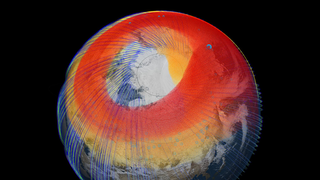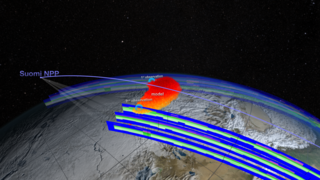The Aftermath of the Chelyabinsk Meteor as seen by NPP
Shortly after local sunrise on February 15th of 2013, a meteor as big as a building reached Earth’s atmosphere and produced a massive explosion above Chelyabinsk, a densely populated Russian metropolis. The highly sensitive OMPS instrument on board NPP observed the plume from the explosion 1,100km eastward. Scientists used the data from this first observation and ran two NASA models to project the path of the plume. The results show that the plume’s higher layer would move ahead of the lower layer due to the difference in wind velocity at higher and lower altitudes. The models also showed that the plume would circumnavigate the entire globe and return to Chelyabinsk by February 19th, 2013. As more OMPS observations came in, it was clear that they coincided with the projected path perfectly. The results from this study proved the accuracy of the models as well as the unprecedented sensitivity of the OMPS instrument. The OMPS instrument was able to detect remains of the plume months after the initial explosion, which helped scientists track and study the plume for a long period of time. Since the Earth is constantly impacted by meteoric debris, an instrument like OMPS gives the scientists hope that in its 5-year design lifetime, they will better understand the effect of meteors and particles on the stratosphere, as well as the chemistry of our stratosphere and atmospheric ozone layer.
Related
For More Information
Credits
Horace Mitchell (NASA/GSFC): Animator
Silvia Stoyanova (USRA): Video Editor
Mike Velle (HTSI): Narrator
Silvia Stoyanova (USRA): Producer
Paul Newman (NASA/GSFC): Scientist
Nick Gorkavyi (SSAI): Scientist
Arlindo M. Da Silva (NASA/GSFC): Scientist
Didier Rault (USRA): Scientist
Swarupa Nune (Vantage): Project Support
Silvia Stoyanova (USRA): Writer
NASA's Goddard Space Flight Center
https://svs.gsfc.nasa.gov/11336
Mission:
NPP
This item is part of this series:
Narrated Movies
Goddard TV Tape:
G2013-070 -- Russian Meteorite
Keywords:
SVS >> HDTV
GCMD >> Earth Science >> Atmosphere
DLESE >> Narrated
SVS >> Polar-orbiting
SVS >> NPP
NASA Science >> Earth
NASA Science >> Planets and Moons
SVS >> OMPS
SVS >> Chelyabinsk
SVS >> Russian
SVS >> Meteor
SVS >> Plume
SVS >> Bolide
GCMD keywords can be found on the Internet with the following citation: Olsen, L.M., G. Major, K. Shein, J. Scialdone, S. Ritz, T. Stevens, M. Morahan, A. Aleman, R. Vogel, S. Leicester, H. Weir, M. Meaux, S. Grebas, C.Solomon, M. Holland, T. Northcutt, R. A. Restrepo, R. Bilodeau, 2013. NASA/Global Change Master Directory (GCMD) Earth Science Keywords. Version 8.0.0.0.0













